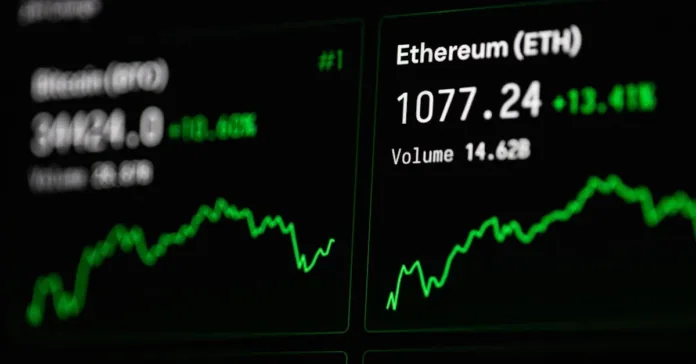In a turbulent start to the trading week, the cryptocurrency market experienced a significant downturn as both Bitcoin (BTC) and Ethereum (ETH) witnessed substantial declines, plunging by around 5% ahead of the widely-anticipated Federal Reserve rate cuts. This market downturn has left crypto sentiment on edge, as traders and investors navigate the complex interplay between digital assets, monetary policy, and the broader financial markets.
Bitcoin Sees Steep Drop, but ETF Inflows Remain Strong
Bitcoin, the flagship cryptocurrency, began the week with a 3% decline, with the current Bitcoin price falling below the $58,400 mark. This drop was in line with the broader Bitcoin index, as the CoinDesk 20 index, a measure of the largest digital assets, also saw a 5% decline. Despite the price dip, Bitcoin ETFs continued to garner investor interest, with U.S.-listed funds recording a significant inflow of over $263 million on Friday – the highest since July 22.
Ethereum, the second-largest cryptocurrency by market capitalization, led the losses among major digital assets, with a 5.5% drop over the past 24 hours, marking its worst one-day slide since early August. The Ethereum network has faced increasing Ethereum competition from emerging blockchain platforms, such as Solana and Base, which have captured more attention and potentially impacted the demand for ETH.
Related Read: Trump Safe After Second Assassination Attempt; Bitcoin Dips
Anticipation Builds for Federal Reserve’s Rate Cut Decision
The crypto market trends came ahead of expectations of the U.S. Federal Reserve potentially cutting interest rates, a move that has historically influenced investor sentiment. According to data from Polymarket, traders are giving a 51% chance of a 50-basis-point cut and a 48% chance of a 25-basis-point cut, with only a 2% chance of no change in the Fed funds target.
A pivot towards lower borrowing costs, or a more dovish stance, has typically buoyed bullish sentiment among traders, as cheap access to money can spur growth in riskier sectors, including the cryptocurrency market. However, the Federal Reserve impact on crypto remains to be seen, as the market grapples with its own unique set of challenges and dynamics amid broader market uncertainty.
Altcoins Struggle Amid Market Downturn
The cryptocurrency market’s downturn was not limited to Bitcoin and Ethereum, as several altcoins also experienced significant losses, tempering altcoin potential. Cardano’s ADA fell by 5%, while Solana’s SOL lost 4% of its value. BNB Chain’s BNB emerged as the best performer among the majors, with a relatively modest 1.1% decline.
One notable exception was Nervos’ CKB, which bucked the trend and saw a 10.5% jump in the last 24 hours, likely driven by continued positive sentiment after the token was listed on the Korean exchange Upbit, where traders have a strong appetite for meme-inspired cryptocurrencies.
Futures Traders Suffer Losses Amid Sudden Drop
The market’s sudden decline also took a toll on futures traders, with data from CoinGlass showing that traders betting on higher crypto prices lost over $143 million amid the sudden drop. This underscores the market volatility and risk inherent in the cryptocurrency derivatives market, where leveraged positions can amplify both gains and losses.
Ethereum Faces Mounting Competition
The Ethereum network, which has long been a dominant force in the cryptocurrency ecosystem, has faced increasing competition from emerging blockchain platforms. Solana, in particular, has emerged as a popular destination for the launch of meme-inspired cryptocurrencies, while new chains like Base and the Telegram-affiliated TON project have also captured more mindshare, potentially impacting the demand for ETH.
Furthermore, the widely-watched BTC/ETH ratio, which tracks the relative movement of the two largest tokens, has fallen to four-year lows, indicating that Ethereum’s dominance has been waning compared to Bitcoin.
Sony’s Soneium Blockchain Enters the Fray
Adding to the competitive landscape, Sony‘s Soneium blockchain has also been making strides, with the announcement that the stablecoin USDC will be offered on the chain. While the specific details of the USDC integration were not provided, this development suggests that Sony’s blockchain project is gaining traction and may potentially challenge Ethereum’s position in certain use cases.
Navigating the Crypto Rollercoaster: Lessons for Investors
The recent volatility in the cryptocurrency market serves as a stark reminder for investors to exercise caution and diligence when navigating this rapidly evolving landscape. The interconnected nature of digital assets, macroeconomic policies like inflation, unemployment rate, oil prices, and commodities, and emerging blockchain ecosystems underscores the need for a comprehensive understanding of the factors driving market volatility.
As the Federal Reserve meeting crypto looms, traders and investors will need to closely monitor the potential implications for the broader risk-off sentiment and the relative performance of different digital assets. The ability to adapt to these shifting dynamics and make informed decisions will be crucial in weathering the crypto rollercoaster, whether it’s understanding why crypto is up or why crypto is down.
Conclusion: Preparing for Volatility and Embracing Transparency
The cryptocurrency market’s recent turbulence, influenced by factors like rate cut expectations, liquidity injection, and recession fears, serves as a stark reminder of the inherent volatility that characterizes this asset class. As the industry continues to evolve, with new players and competitive forces emerging, investors must remain vigilant and proactive in their approach to managing their crypto portfolios.
By staying informed on the latest crypto news, diversifying their holdings into the best cryptos to invest, and embracing transparency, crypto enthusiasts can better position themselves to navigate the market’s ups and downs and capitalize on the long-term potential of digital risk assets. As the industry matures, the ability to navigate the complex interplay between cryptocurrency, FOMC crypto decisions, economic projections, and emerging blockchain ecosystems will be a critical skill for investors seeking to thrive in this dynamic and ever-changing landscape, whether they’re focused on short-term stock market reaction or a long-term investing strategy.













